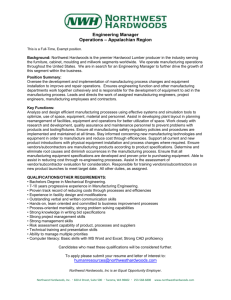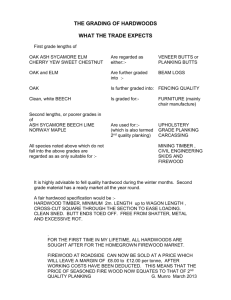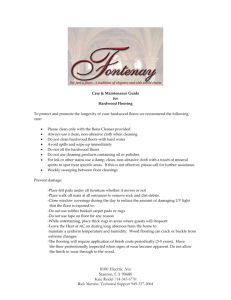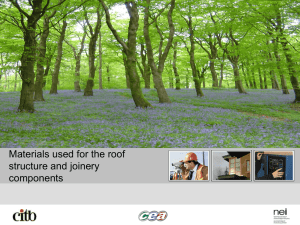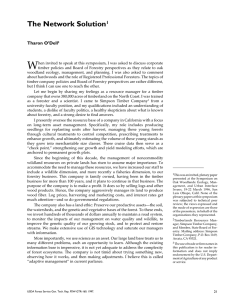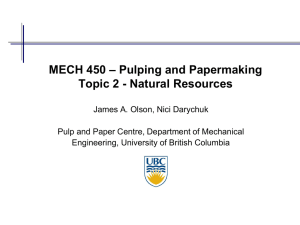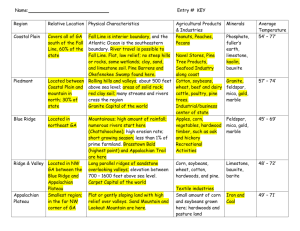North American Hardwoods and their Role in Carbon Neutral Design
advertisement
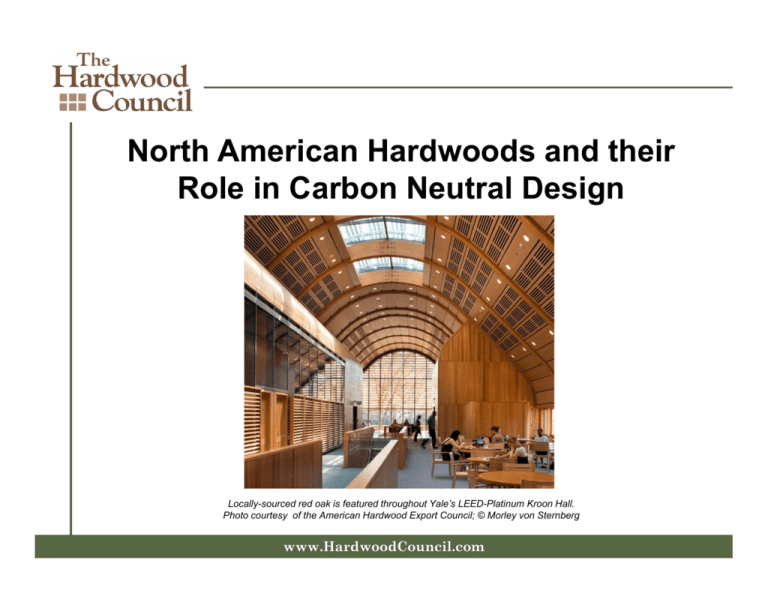
North American Hardwoods and their Role in Carbon Neutral Design Locally-sourced red oak is featured throughout Yale’s LEED-Platinum Kroon Hall. Photo courtesy of the American Hardwood Export Council; © Morley von Sternberg www.HardwoodCouncil.com What are North American Hardwoods? Hardwoods are deciduous trees. • Have broad leaves • Produce a fruit or nut America’s forests grow hundreds of varieties of hardwood trees. Photos courtesy of the American Hardwood Export Council. www.HardwoodCouncil.com What are North American Hardwoods? Each species has a unique cellular structure, which creates differences in physical properties. Vessel Elements Bands of Fiber Bands of Fiber Bands of Vascular Cells Bands of Vascular Cells Softwood Hardwood www.HardwoodCouncil.com What are North American Hardwoods? The Janka Rating System measures the relative hardness of woods. Janka Scale Typical North American Hardwoods Hardness Hickory/Pecan 1820 Hard Maple/Sugar Maple 1450 White Oak 1360 Red Oak (Northern) 1290 Walnut 1010 Cherry 950 Elm 830 Chestnut 540 www.HardwoodCouncil.com Where Do They Grow and How Abundant are They? There are 514 million acres of timberland in the United States. Of all temperate forests in the world, North American forests have the most diverse hardwood species. www.HardwoodCouncil.com www.HardwoodCouncil.com Where Do They Grow and How Abundant are They? The average annual net growth of hardwoods exceeds removals, by a ratio of 2.00. Forest Resources of the United States, by the U.S. Department of Agriculture, 2007 www.HardwoodCouncil.com Who Owns Them? Forest Resources of the United States, by the U.S. Department of Agriculture, 2007 www.HardwoodCouncil.com Who Owns Them? Forest Ownership in the Continental U.S., 2006 www.HardwoodCouncil.com Hardwoods—How Do We Get Them? Silviculture: the art and science of controlling the establishment, growth, composition, health and quality of forests to meet diverse needs and values. Photo courtesy of the American Hardwood Export Council. www.HardwoodCouncil.com Hardwoods—How Do We Get Them? Responsible Forest Management Practices Photo courtesy of Mark Bolster. www.HardwoodCouncil.com Hardwoods—How Do We Get Them? Single-tree selection is the predominate harvesting method in hardwood forestry, not clear-cutting. Photo courtesy of the American Hardwood Export Council. www.HardwoodCouncil.com Hardwoods—How Do We Get Them? In a hardwood forest, trees compete for water and sunlight. Photos courtesy of the American Hardwood Export Council. www.HardwoodCouncil.com Hardwoods—How Do We Get Them? Manufacturing technology assures the least wood waste and greatest yield of lumber. Photos courtesy of the American Hardwood Export Council. www.HardwoodCouncil.com Hardwoods—How Do We Get Them? All wood processing by-products have a use. • • • • • • Mulch Soil Conditioners Combustible Fuel Animal Bedding Paper Wood Components Photo courtesy of the American Hardwood Export Council. www.HardwoodCouncil.com Hardwoods—How Do We Get Them? The Volume in hardwood forests has increased 119% from 1953 – 2007. Forest Resources of the United States, by the U.S. Department of Agriculture, 2007 www.HardwoodCouncil.com The Incredible Facts about Wood and Carbon www.HardwoodCouncil.com Greenhouse Gas Producers www.HardwoodCouncil.com The Incredible Facts about Wood and Carbon Growing trees: • Remove CO2 • Return oxygen • Use carbon • Store carbon Graphic created by the University Corporation for Atmospheric Research www.HardwoodCouncil.com The Incredible Facts about Wood and Carbon Wood products require less energy to manufacture. Compare the amount of energy required to produce one ton of cement, glass, steel, or aluminum to the production of 1 ton of wood: Cement 5x more energy Glass 14x more energy Steel 24x more energy Aluminum 126x more energy Wood products make up 47% of all industrial raw materials manufactured in the U.S., but consume only 4% of the energy required to manufacture those materials. Engineered Wood Association, www.apawood.org www.HardwoodCouncil.com Table 1: Net Carbon (C) Emissions in Producing a Ton of Various Materials Net Carbon Emissions (kg C/metric ton)a/ b/ Net Carbon Emissions Including Carbon Storage Within Material (kg C/metric ton)c/ Framing lumber 33 -457 Medium density fiberboard (virgin fiber) 60 -382 Brick 88 88 Glass 154 154 Recycled steel (100% from scrap) 220 220 Concrete 265 265 Concrete blockd/ 291 291 Recycled aluminum (100% recycled content) 309 309 Steel (virgin) 694 694 Plastic 2,502 2,502 Aluminum (virgin) 4,532 4,532 Material a/ Values are based on life cycle assessment and include gathering and processing of raw materials, primary and secondary processing, and transportation. b/ Source: USEPA (2006). c/ A carbon content of 49% is assumed for wood. d/ Derived based on EPA value for concrete and consideration of additional steps involved in making blocks. www.HardwoodCouncil.com The Incredible Facts about Wood and Carbon www.HardwoodCouncil.com The Incredible Facts about Wood and Carbon Some fire is a natural part of a forest’s ecosystem. The National Interagency Fire Center provides nationwide wildfire statistics. Visit http://lwf.ncdc.noaa.gov/sotc/?report=fire. www.HardwoodCouncil.com Life Cycle Assessment and North American Hardwoods Life Cycle Assessment is the evaluation of a product’s impact on the environment through its total existence. Image Source: Athena Institute www.HardwoodCouncil.com Life Cycle Assessment and North American Hardwoods www.HardwoodCouncil.com Life Cycle Assessment and North American Hardwoods Consortium for Research on Renewable Industrial Materials www.CORRIM.org www.HardwoodCouncil.com Life Cycle Assessment and North American Hardwoods 80 Life Expectancy of Common Flooring Materials 70 60 50 40 30 20 10 0 Generic Vinyl Composition Tile Generic Linoleum Flooring Generic Nylon Generic Wool Carpet Tile Carpet Tile Solid Hardwood Flooring Source: National Wood Flooring Association and the Consortium for Research on Renewable Industrial Materials, 2007 – 2008 www.HardwoodCouncil.com Life Cycle Assessment and North American Hardwoods 100-year-old white oak floors meet the demands of this high-traffic area. Photo © National Wood Flooring Association. www.HardwoodCouncil.com Life Cycle Assessment and North American Hardwoods Other assessment tools have emerged and are under continuous development. • SimaPro Model • Athena™ Environmental Impact Estimator • Shows wood has the lowest environmental impact when compared to steel and concrete • BEES® (Building for Environmental and Economic Stability) www.HardwoodCouncil.com Environmental Attributes of North American Hardwoods • Sequester carbon • Sustainable resource • Minimal energy consumption • Eco‐Friendly disposal or repurposing • Low carbon footprint www.HardwoodCouncil.com “Green” Building and the AIA 2030 Challenge Image courtesy Wikipedia Creative Commons www.HardwoodCouncil.com “Green” Building and the AIA 2030 Challenge Maple flooring and alder casework , doors and paneling were sourced within 500 miles of Seminar II, in Olympia, Wash. Photo courtesy of the Evergreen State College. www.HardwoodCouncil.com The 2030 Challenge www.HardwoodCouncil.com “Green” Building and the AIA 2030 Challenge North American hard maple is featured in Spain’s Castellón Auditorium and Conference Hall. Photo courtesy the American Hardwood Export Council. www.HardwoodCouncil.com The Voice of Congress • House Resolution 81 • Senate Resolution 411 www.govtrack.us www.HardwoodCouncil.com Carbon-Neutral Design — Using North American Hardwoods How North American Hardwoods Compare North American hardwoods are an all-natural material. With hardwood floors for example, there is no place to harbor pollen or animal dander, or for mold to grow. Cutting and drying of lumber is all that is required. Virtually every part of a log is used as lumber or by-products, including bark, sawdust, and scrap. Regionally sourced North American hardwoods don’t incur burning fossil fuels to transport them across the ocean. Some foreign countries have no governing agencies to assure quality standards or environmentally safe manufacturing practices. In the U.S., quality standards and safe manufacturing practices are regulated by U.S. agencies and associations. With the proper finish, hardwood products require minimal maintenance, like dusting or occasional buffing. Minimal maintenance is required. Typical repair is refinishing. A solid hardwood floor can last up to 125 years or longer with several refinishings. Museum quality furniture can last centuries. Hardwood products can be repurposed or used as a combustible fuel. If in a landfill, hardwoods naturally decay and return to nature, unlike many synthetics and plastics which will remain almost indefinitely. www.HardwoodCouncil.com Carbon-Neutral Design — Using North American Hardwoods The Aldo Leopold Legacy Center, Baraboo, Wisc. • • • • First-ever LEED Platinum building Net-Zero Energy Building Uses 70% less energy than a code-compliant building Solar array produces 110% of energy needs Photo courtesy the Aldo Leopold Legacy Center. www.HardwoodCouncil.com Carbon-Neutral Design — Using North American Hardwoods The use of locally-harvested wood products was key. • • • • Ash Cherry Maple Oak Visit www.aldoleopold.org/legacycenter for more information. Photo courtesy the Aldo Leopold Legacy Center. www.HardwoodCouncil.com Choose North American Hardwoods North American red oak is featured in the Amsterdam Conservatory. Photo courtesy the American Hardwood Export Council. www.HardwoodCouncil.com Choose North American Hardwoods Material Selection will play an important role in carbon-neutral buildings Maple glulams and cherry paneling are featured in Penn State’s Forest Resources Building. Photo © Warren Jagger Photography. www.HardwoodCouncil.com Choose North American Hardwoods North American hardwoods: Naturally Renewing Abundant Sustainable Photo courtesy of the American Hardwood Export Council. www.HardwoodCouncil.com Choose North American Hardwoods North American hardwoods can make a difference in attaining carbon neutrality. Locally-sourced red oak is featured throughout Yale’s LEED-Platinum Kroon Hall. Photo courtesy of the American Hardwood Export Council. www.HardwoodCouncil.com Your ideas for Marketing! Don’t “preach to the choir”, get the word out! Start the conversation with the new American Hardwood Selector App! www.HardwoodCouncil.com Your ideas for Marketing! ‐Let your contacts & followers know about sustainable woods in your project with your social media and mass emails. ‐Use the Hardwood Councils resources www.HardwoodCouncil.com Your ideas for Marketing! ‐Sponsor and man a trade show exhibit www.HardwoodCouncil.com Your ideas for Marketing! ‐Sponsor a webinar ‐Host a forest tour www.HardwoodCouncil.com Thank You For Attending! Questions? www.HardwoodCouncil.com info@HardwoodCouncil.com 412.244.0440 www.HardwoodCouncil.com
